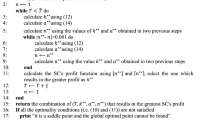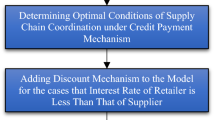Abstract
In a decentralized supply chain (SC), each member individually makes decisions according to its personal objectives while these decisions impact on the other SC actors. The promotional effort made by retailers is one of the main factors that largely impacts on the market demand of a commodity, which in turn boosts the profitability of the whole SC members. In this paper, we investigate coordination of promotional effort and replenishment decisions in a two-echelon SC including single supplier and single retailer. The investigated SC faces a stochastic demand influenced by the retailer’s promotional effort. To replenish items, the retailer uses a periodic review inventory system and decides on the review period, order-up-to-level and promotional effort. On the other side, the supplier employs a periodic review lot-for-lot strategy and determines its replenishment cycle multiplier. Firstly, we model the SC under the decentralized and centralized decision-making models. Exact solution procedures are presented using mathematical and concavity analysis to obtain the decentralized and centralized optimal solutions. Afterwards, a coordination model based on delay in payment contract is proposed to motivate the retailer to participate in the joint decision-making model. To create a more realistic model, in the proposed models we assume that the SC members’ rates of return on investment are different. The minimum and maximum length of credit period which are acceptable to both members are determined. Finally, numerical examples and sensitivity analysis are conducted to investigate the performance and applicability of the developed models. The results show that the proposed coordination scheme considerably improves the profitability of both SC members and the whole SC in comparison with the decentralized setting.






Similar content being viewed by others
References
Aljazzar SM, Jaber MY, Moussawi-Haidar L (2016) Coordination of a three-level supply chain (supplier–manufacturer–retailer) with permissible delay in payments. Appl Math Model 40(21):9594–9614
Arkan A, Hejazi SR (2012) Coordinating orders in a two echelon supply chain with controllable lead time and ordering cost using the credit period. Comput Ind Eng 62(1):56–69
Axsäter S (1993) Optimization of order-up-to-s policies in two-echelon inventory systems with periodic review. Naval Res Logist (NRL) 40(2):245–253
Bai Q, Chen M, Xu L (2017) Revenue and promotional cost-sharing contract versus two-part tariff contract in coordinating sustainable supply chain systems with deteriorating items. Int J Prod Econ 187:85–101
Bai Q, Xu X, Xu J, Wang D (2016) Coordinating a supply chain for deteriorating items with multi-factor-dependent demand over a finite planning horizon. Appl Math Model 40(21):9342–9361
Cao E, Wan C, Lai M (2013) Coordination of a supply chain with one manufacturer and multiple competing retailers under simultaneous demand and cost disruptions. Int J Prod Econ 141(1):425–433
Cárdenas-Barrón LE, Sana SS (2015) Multi-item EOQ inventory model in a two-layer supply chain while demand varies with promotional effort. Appl Math Model 39(21):6725–6737
Chaharsooghi SK, Heydari J (2010) Supply chain coordination for the joint determination of order quantity and reorder point using credit option. Eur J Oper Res 204(1):86–95
Chaharsooghi SK, Heydari J, Kamalabadi IN (2011) Simultaneous coordination of order quantity and reorder point in a two-stage supply chain. Comput Oper Res 38(12):1667–1677
Duan Y, Huo J, Zhang Y, Zhang J (2012) Two level supply chain coordination with delay in payments for fixed lifetime products. Comput Ind Eng 63(2):456–463
Gao D, Zhao X, Geng W (2014) A delay-in-payment contract for Pareto improvement of a supply chain with stochastic demand. Omega 49:60–68
Gurnani H, Erkoc M (2008) Supply contracts in manufacturer-retailer interactions with manufacturer-quality and retailer effort-induced demand. Naval Res Logist (NRL) 55(3):200–217
Heydari J (2015) Coordinating replenishment decisions in a two-stage supply chain by considering truckload limitation based on delay in payments. Int J Syst Sci 46(10):1897–1908
Hojati S, Seyedhosseini SM, Hosseini-Motlagh SM, Nematollahi M (2017) Coordination and profit sharing in a two-level supply chain under periodic review inventory policy with delay in payments contract. J Indus Syst Eng 10:109–131
Hsu SL, Lee CC (2009) Replenishment and lead time decisions in manufacturer–retailer chains. Transp Res Part E: Logist Transp Rev 45(3):398–408
Johari M, Hosseini-Motlagh SM, Nematollahi M (2017) Simultaneous coordination of review period and order-up-to-level in a manufacturer-retailer chain. J Indus Syst Eng 10:1–17
Kanchanasuntorn K, Techanitisawad A (2006) An approximate periodic model for fixed-life perishable products in a two-echelon inventory–distribution system. Int J Prod Econ 100(1):101–115
Li L, Wang Y, Dai W (2016) Coordinating supplier retailer and carrier with price discount policy. Appl Math Model 40(1):646–657
Lin YJ (2010). A stochastic periodic review integrated inventory model involving defective items, backorder price discount, and variable lead time. 4OR 8(3):281–297
Ma P, Wang H, Shang J (2013) Contract design for two-stage supply chain coordination: Integrating manufacturer-quality and retailer-marketing efforts. Int J Prod Econ 146(2):745–755
Mallidis I, Vlachos D, Iakovou E, Dekker R (2014) Design and planning for green global supply chains under periodic review replenishment policies. Transp Res Part E: Logist Transp Rev 72:210–235
Montgomery DC, Bazaraa MS, Keswani AK (1973) Inventory models with a mixture of backorders and lost sales. Naval Res Logist Quart 20(2):255–263
Nematollahi M, Hosseini-Motlagh SM, Heydari J (2017) Coordination of social responsibility and order quantity in a two-echelon supply chain: A collaborative decision-making perspective. Int J Prod Econ 184:107–121
Nematollahi M, Hosseini-Motlagh SM, Heydari J (2017) Economic and social collaborative decision-making on visit interval and service level in a two-echelon pharmaceutical supply chain. J Clean Prod 142:3956–3969
Sarathi GP, Sarmah SP, Jenamani M (2014) An integrated revenue sharing and quantity discounts contract for coordinating a supply chain dealing with short life-cycle products. Appl Math Model 38(15):4120–4136
Song DP, Dong JX, Xu J (2014) Integrated inventory management and supplier base reduction in a supply chain with multiple uncertainties. Eur J Oper Res 232(3):522–536
Titah R, Shuraida S, Rekik Y (2016) Integration breach: Investigating the effect of internal and external information sharing and coordination on firm profit. Int J Prod Econ 181:34–47
Tsao YC (2010) Managing multi-echelon multi-item channels with trade allowances under credit period. Int J Prod Econ 127(2):226–237
Zhou Y, Bao M, Chen X, Xu X (2016) Co-op advertising and emission reduction cost sharing contracts and coordination in low-carbon supply chain based on fairness concerns. J Clean Prod 133:402–413
Author information
Authors and Affiliations
Corresponding author
Appendix
Appendix
1.1 Appendix A. Proof of proposition 1
To prove concavity with respect to \(k\) and \(a\) for a given \(T\), the Hessian matrix of the retailer’s profit function for a given \(T\) is calculated:
where,
The first principal minor of the above Hessian matrix (\({H_{11}}\)) has a negative value. Also, the second principal minor (\({H_{22}}\)) is always positive. Therefore, the Hessian matrix is negative definite and therefore the retailer’s profit function is concave with respect to \(k\) and \(~a\) for a given \(T\). By optimizing the retailer’s profit function with respect to \(k\) and \(a\), the optimal values of \(k\) and \(a~\) for a given \(T\) will be:
1.2 Appendix B. Proof of proposition2
To prove concavity with respect to \(n\), it is sufficient to indicate that second-order derivative of \({\Pi _S}(n)\) with respect to \(n\) is negative. The first order and second order derivatives of \({\Pi _S}(n)\) with respect to \(n\) can be calculated as follows:
The second order derivative of \({\Pi _S}(n)\) has negative value. Hence, the supplier’s profit function is concave with respect to \(n\). By setting Eq. [30] equal to zero, the optimal value of \(n\) can be calculated as:
1.3 Appendix C. Proof of proposition 3
To prove concavity with respect to \(k,~a,~n\) for a given \(~T\), the Hessian matrix is calculated as follows:
The first principal minor of the above Hessian matrix (\({H_{11}}\)) has a negative value. Also, the second principal minor (\({H_{22}}\)) is always positive and the third principal minor (\({H_{33}}\)) is negative under the condition. Therefore, the Hessian matrix is negative definite, thus the SC’s profit function is concave with respect to \(k,~a,~n\) for a given \(T\). By optimizing the SC’s profit function with respect to \(k,~a,~n\), the optimal values of \(k,~a,~n\) for a given \(T\) will be:
Rights and permissions
About this article
Cite this article
Ebrahimi, S., Hosseini-Motlagh, SM. & Nematollahi, M. Proposing a delay in payment contract for coordinating a two-echelon periodic review supply chain with stochastic promotional effort dependent demand. Int. J. Mach. Learn. & Cyber. 10, 1037–1050 (2019). https://doi.org/10.1007/s13042-017-0781-6
Received:
Accepted:
Published:
Issue Date:
DOI: https://doi.org/10.1007/s13042-017-0781-6




